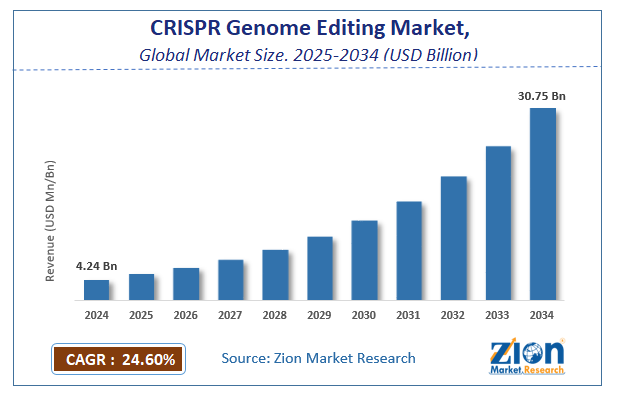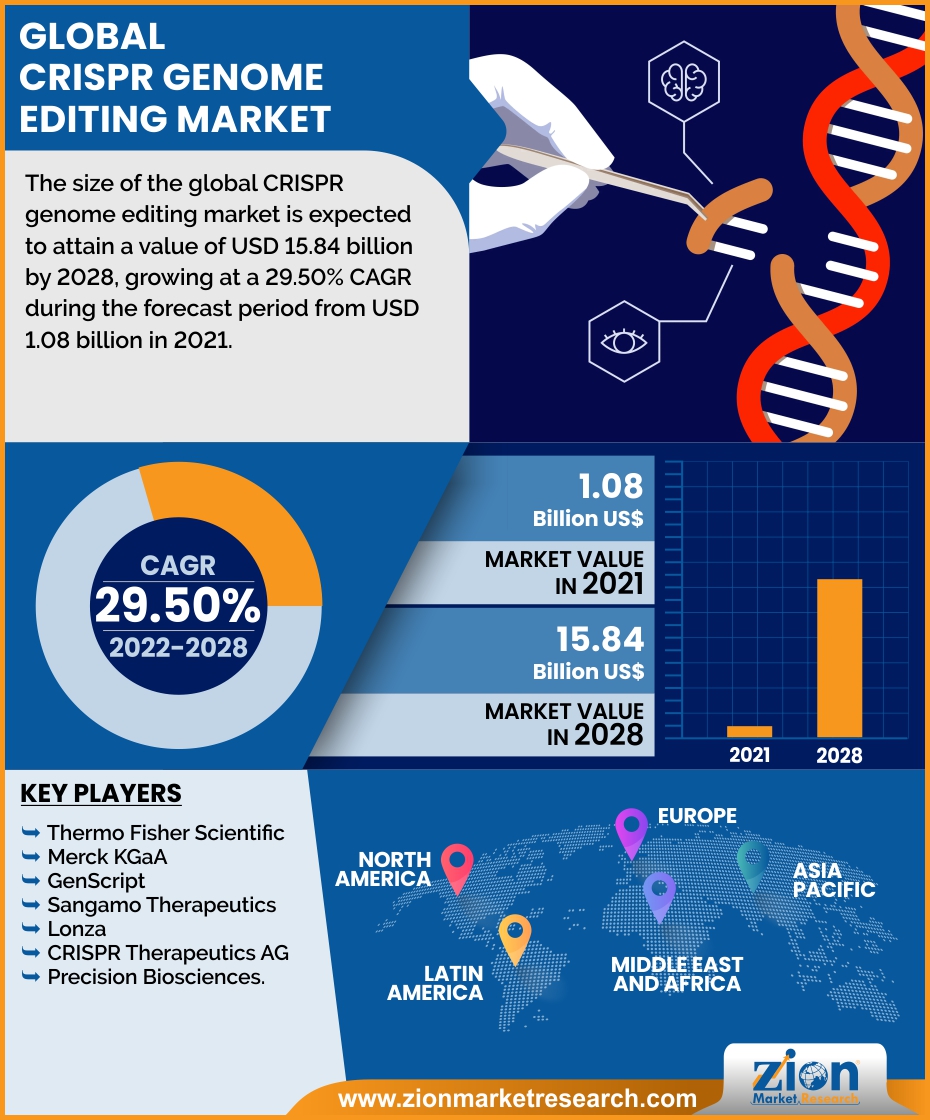Global CRISPR Genome Editing Market Size, Share, Growth Analysis Report - Forecast 2034

CRISPR Genome Editing Market By End-User (Academics & Government Institutes, Biotechnology & Pharma Companies, Contract Research Organizations, & Others), By Application (Cell Line Engineering, Genetic Engineering, Diagnostic Applications, Drug Discovery & Development, & Others), and By Region: Global and Regional Industry Overview, Market Intelligence, Comprehensive Analysis, Historical Data, and Forecasts 2025 - 2034
| Market Size in 2024 | Market Forecast in 2034 | CAGR (in %) | Base Year |
|---|---|---|---|
| USD 4.24 Billion | USD 30.75 Billion | 24.6% | 2024 |
CRISPR Genome Editing Market Size
The global crispr genome editing market size was worth around USD 4.24 Billion in 2024 and is predicted to grow to around USD 30.75 Billion by 2034 with a compound annual growth rate (CAGR) of roughly 24.6% between 2025 and 2034.
The report analyzes the global crispr genome editing market's drivers, restraints/challenges, and the effect they have on the demands during the projection period. In addition, the report explores emerging opportunities in the crispr genome editing industry.
CRISPR Genome Editing Market: Overview
In Global CRISPR Genome Editing Market Report, CRISPR gene editing is a molecular genetically engineered approach for altering the genomes of living organisms. It's built on a reduced form of the CRISPR-Cas9 antiviral defense mechanism found in bacteria. The approach is important in biotechnology and medicine because it enables genes to be altered in vivo with exceptional accuracy, at a low cost, and with simplicity. It can be employed in the development of novel medications, farm goods, and genetically engineered organisms, as well as for disease and pest management. It may also be used to treat heritable gene illnesses and also diseases that are caused by somatic mutations.
Key Insights
- As per the analysis shared by our research analyst, the global crispr genome editing market is estimated to grow annually at a CAGR of around 24.6% over the forecast period (2025-2034).
- Regarding revenue, the global crispr genome editing market size was valued at around USD 4.24 Billion in 2024 and is projected to reach USD 30.75 Billion by 2034.
- The crispr genome editing market is projected to grow at a significant rate due to rising investments in genetic research, increasing demand for precision medicine, growing applications in drug discovery and agriculture, and advancements in CRISPR technology for therapeutic and biotechnological innovations.
- Based on End-User, the Academics & Government Institutes segment is expected to lead the global market.
- On the basis of Application, the Cell Line Engineering segment is growing at a high rate and will continue to dominate the global market.
- Based on region, North America is predicted to dominate the global market during the forecast period.
CRISPR Genome Editing Market: Growth Drivers
Rise in government funding for CRISPR genome editing projects to drive market growth
Governments in numerous nations throughout the world have made large expenditures in genomics in past years, which have aided in the discovery and research of innovative CRISPR genome editing technologies. Furthermore, the availability of funding support has allowed university and government organizations to conduct extensive genome engineering research. The quantity of CRISPR genomics research efforts has increased significantly as a result of major government funding in genomics. This, in turn, is likely to fuel the global CRISPR genome editing market's expansion throughout the forecast period.
CRISPR Genome Editing Market: Restraints
Off-target effects likely to restrict the market growth
Off-target consequences from CRISPR-Cas9 are a big problem. Because Cas9 causes double-stranded breaks can potentially lead to cancer tumor formation. Moreover, the high incidence of off-target activity mutations in locations besides the targeted on-target location is a major source of worry. CRISPR can, for example, target a tumor suppressor gene or stimulate a cancer-causing mutation. This unfavorable consequence has caused problems for several firms conducting clinical studies. Clinical studies have been halted, and regulatory officials are demanding further study to improve the method's safety thereby restraining the market growth.
CRISPR Genome Editing Market: Opportunities
Use of CRISPR in agriculture to provide growth opportunities for market
CRISPR allows for desired agricultural features by transferring DNA from the crop's own naturally occurring genetic variants, rather than from alternative reproductively incompatible creatures. This removes the possibility of foreign DNA contamination in the resulting plant and final items. Because the CRISPR procedure does not incorporate foreign DNA into the genetic material, many scientific experts regard plant products to be non-GMO, and at least some plants generated using this technology are non-GMO. This expands its application in agriculture, offering the potential for the worldwide CRISPR genome editing market to expand.
CRISPR Genome Editing Market: Challenges
Ethical concerns regarding human gene editing using CRISPR to challenge the market growth
Human genome editing, according to bioethicists and experts, should not be tried since it affects genes and has a mutant impact that may be passed down generations. The majority of stakeholders feel that ongoing public discourse and debate are necessary to allow the public to determine whether or not CRISPR genome editing must be permitted for human genes. Because of bioethical concerns, around 40 nations prohibited or outlawed CRISPR genome editing research in the last decade. This has hampered the worldwide CRISPR genome editing business by constraining further research and development.
CRISPR Genome Editing Market: Segmentation Analysis
The global market is segregated on the basis of end-user, application, and region.
Based on End-User, the global crispr genome editing market is divided into Academics & Government Institutes, Biotechnology & Pharma Companies, Contract Research Organizations, & Others. Biotechnology & pharmaceutical businesses accounted for the greatest proportion of the global CRISPR genome editing market by end-user in 2021. Infectious illnesses and cancer are becoming more common, which is fueling research efforts throughout the world. The need for genetic modification in biotechnology and pharmaceutical industries is likely to rise as a result of this.
On the basis of Application, the global crispr genome editing market is bifurcated into Cell Line Engineering, Genetic Engineering, Diagnostic Applications, Drug Discovery & Development, & Others. The bulk of the market was responsible for the application of CRISPR technology for cell line genetic alteration in stem cell treatment and gene therapy, and it is predicted to grow fast. The ability to use this technology to create new compounds that may be used to treat diseases like malignant tumors and contagious diseases is anticipated to boost its popularity in the coming years.
CRISPR Genome Editing Market: Report Scope
| Report Attributes | Report Details |
|---|---|
| Report Name | CRISPR Genome Editing Market |
| Market Size in 2024 | USD 4.24 Billion |
| Market Forecast in 2034 | USD 30.75 Billion |
| Growth Rate | CAGR of 24.6% |
| Number of Pages | 150 |
| Key Companies Covered | Thermo Fisher Scientific, Merck KGaA, GenScript, Sangamo Therapeutics, Lonza, CRISPR Therapeutics AG, Precision Biosciences.,, and others. |
| Segments Covered | By End-User, By Application, and By Region |
| Regions Covered | North America, Europe, Asia Pacific (APAC), Latin America, The Middle East and Africa (MEA) |
| Base Year | 2024 |
| Historical Year | 2020 to 2023 |
| Forecast Year | 2025 - 2034 |
| Customization Scope | Avail customized purchase options to meet your exact research needs. Request For Customization |
Recent Developments
- In 2020, Canadian Government provided a support of around USD 14-15 million through the Ministry of Innovation Science and Industry Science to Genome Canada for supporting research in 11 CRISPR genome editing projects in field of health (reproduction and cancer), agriculture, and environmental preservation.
- In 2021, a new gene-editing platform was launched at the University of Liverpool in collaboration with Inscripta to promote research of CRISPR genome editing.
CRISPR Genome Editing Market: Regional Landscape
North America to lead the global market during the coming period
Due to significant investments made by pharmaceutical & biotech businesses, rise in per capita income, enhanced health systems, accessibility of therapies, and affordability of state-of-the-art testing facilities & organizations in the region, North America has the largest proportion of the CRISPR gene editing market. Apart from that, throughout the forecast period, Asia Pacific is expected to develop at the quickest CAGR in the global CRISPR genome editing market.
CRISPR Genome Editing Market: Competitive Analysis
The report provides a company market share analysis to give a broader overview of the key market players. In addition, the report also covers key strategic developments of the market, including acquisitions & mergers, new product launches, agreements, partnerships, collaborations & joint ventures, research & development, and regional expansion of major participants involved in the crispr genome editing market on a global and regional basis.
The global crispr genome editing market is dominated by players like:
- Thermo Fisher Scientific
- Merck KGaA
- GenScript
- Sangamo Therapeutics
- Lonza
- CRISPR Therapeutics AG
- Precision Biosciences.
The global crispr genome editing market is segmented as follows;
By End-User
- Academics & Government Institutes
- Biotechnology & Pharma Companies
- Contract Research Organizations
- & Others
By Application
- Cell Line Engineering
- Genetic Engineering
- Diagnostic Applications
- Drug Discovery & Development
- & Others
By Region
- North America
- The U.S.
- Canada
- Mexico
- Europe
- France
- The UK
- Spain
- Germany
- Italy
- Rest of Europe
- Asia Pacific
- China
- Japan
- India
- Australia
- South Korea
- Rest of Asia Pacific
- The Middle East & Africa
- Saudi Arabia
- UAE
- Egypt
- Kuwait
- South Africa
- Rest of the Middle East & Africa
- Latin America
- Brazil
- Argentina
- Rest of Latin America
Table Of Content
Methodology
FrequentlyAsked Questions
Leading players in the global crispr genome editing market include Thermo Fisher Scientific, Merck KGaA, GenScript, Sangamo Therapeutics, Lonza, CRISPR Therapeutics AG, Precision Biosciences.,, among others.
RelatedNews
HappyClients
Zion Market Research
Tel: +1 (302) 444-0166
USA/Canada Toll Free No.+1 (855) 465-4651
3rd Floor,
Mrunal Paradise, Opp Maharaja Hotel,
Pimple Gurav, Pune 411061,
Maharashtra, India
Phone No +91 7768 006 007, +91 7768 006 008
US OFFICE NO +1 (302) 444-0166
US/CAN TOLL FREE +1 (855) 465-4651
Email: sales@zionmarketresearch.com
We have secured system to process your transaction.
Our support available to help you 24 hours a day, five days a week.
Monday - Friday: 9AM - 6PM
Saturday - Sunday: Closed







